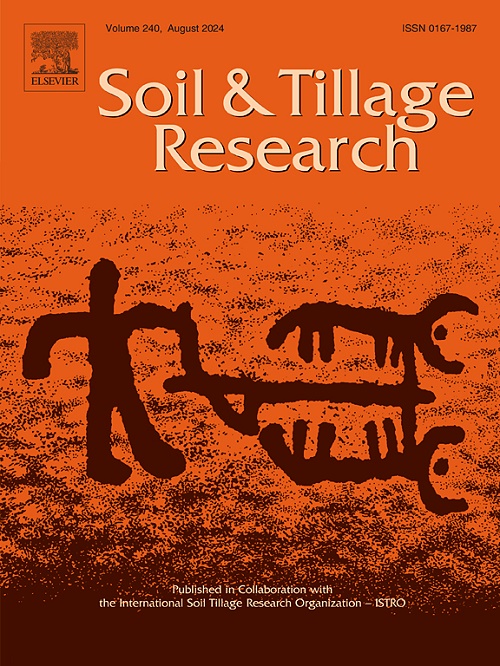Roles of soil organic acids and base cations in Mollisol acidification during the peak growth stage of crops
IF 6.1
1区 农林科学
Q1 SOIL SCIENCE
引用次数: 0
Abstract
Changes in low-molecular-weight organic acids (LMWOAs), plant uptake or leaching of base cations (BCs) during peak crop growth affect soil acidity, particularly owing to excessive fertilizer use and intensive farming. The effect of LMWOAs and BCs on the acidity of Mollisol farmland is poorly understood. A long-term experiment with different fertilizer treatments under continuous cropping or corn–soybean rotation modules, was performed to examine the variation of LMWOAs and BCs during peak growth stages of corn and soybean and their effects on soil acidity. The LMWOAs concentrations ranged from 33.6 to 45.9 mg kg–1 at the jointing stage of corn and 71.2–114 mg kg–1 at the flowering stage of soybean. The predominant LMWOAs for corn are malic, acetic, and propanedioic acids, and malic, propanedioic, and succinic acids for soybean. Acetic acid was the main acidity determinant for corn (r = 0.714, p < 0.001), whereas that for soybean was malic acid (r = 0.704, p < 0.001). Acidification of the Mollisol farmland by LMWOAs and BCs during the peak crop growth stage is crop-specific and management-dependent. The higher total amount of LMWOAs may be one of the reasons for soil acidification in soybean. Continuous corn significantly increases the total LMWOAs concentration but reduces the content of BCs, exchangeable BCs (Ca2+, Mg2+, and Na+), whereas continuous soybean reduces no effect on either LMWOAs or BCs. Continuous corn cultivation, compared to rotational corn, reduces soil pH from 5.76 to 5.63, due to an increase in the total LMWOAs concentration, as well as a reduction in BCs and exchangeable BCs (Ca2+, Mg2+, and Na+) levels. There is no significant difference in soil pH between continuous and rotational soybean treatments but soil pH below 5.5 in both treatments. Rotation with chemical fertilizer for corn and dairy manure alone for soybean increases soil pH significantly owing to higher levels of BCs and exchangeable BCs (Ca2+, Mg2+, and K+). Manure application is more effective than straw return in mitigating soil acidity. Understanding the decomposition dynamics of LMWOAs during the crop cycle on soil acidity is required to lay a robust scientific basis for mitigating soil acidification in Mollisol farmlands.
作物生长高峰期土壤有机酸、碱阳离子在Mollisol酸化中的作用
在作物生长高峰期间,低分子量有机酸(LMWOAs)、植物吸收或碱阳离子(BCs)淋滤的变化会影响土壤酸度,特别是由于过度施肥和集约化耕作。LMWOAs和BCs对Mollisol农田酸度的影响尚不清楚。在玉米-大豆轮作模式和连作模式下,通过不同施肥处理,研究玉米和大豆生长高峰期土壤中LMWOAs和BCs的变化及其对土壤酸度的影响。玉米拔节期LMWOAs浓度为33.6 ~ 45.9 mg kg-1,大豆开花期浓度为71.2 ~ 114 mg kg-1。玉米的主要低分子woas是苹果酸、乙酸和丙二酸,大豆的主要低分子woas是苹果酸、丙二酸和琥珀酸。醋酸是玉米的主要酸度决定因素(r = 0.714,p <; 0.001),而苹果酸是大豆的主要酸度决定因素(r = 0.704,p <; 0.001)。Mollisol农田在作物生长高峰期受LMWOAs和BCs的酸化影响是作物特有的和管理依赖的。低分子woas总量较高可能是大豆土壤酸化的原因之一。玉米连作显著提高了LMWOAs总浓度,但降低了BCs和可交换BCs (Ca2+、Mg2+和Na+)的含量,而大豆连作对LMWOAs和BCs均无影响。与轮作玉米相比,连作玉米使土壤pH从5.76降低到5.63,这是由于低分子woas总浓度的增加,以及BCs和可交换BCs (Ca2+、Mg2+和Na+)水平的降低。大豆连作与轮作处理土壤pH值差异不显著,但均低于5.5。玉米轮作化肥,大豆轮作牛粪,土壤pH值显著增加,这是由于BCs和可交换BCs (Ca2+、Mg2+和K+)含量较高。在缓解土壤酸性方面,施用有机肥比秸秆还田更有效。了解作物周期中低分子woas对土壤酸度的分解动态,为缓解Mollisol农田土壤酸化奠定坚实的科学依据。
本文章由计算机程序翻译,如有差异,请以英文原文为准。
求助全文
约1分钟内获得全文
求助全文
来源期刊

Soil & Tillage Research
农林科学-土壤科学
CiteScore
13.00
自引率
6.20%
发文量
266
审稿时长
5 months
期刊介绍:
Soil & Tillage Research examines the physical, chemical and biological changes in the soil caused by tillage and field traffic. Manuscripts will be considered on aspects of soil science, physics, technology, mechanization and applied engineering for a sustainable balance among productivity, environmental quality and profitability. The following are examples of suitable topics within the scope of the journal of Soil and Tillage Research:
The agricultural and biosystems engineering associated with tillage (including no-tillage, reduced-tillage and direct drilling), irrigation and drainage, crops and crop rotations, fertilization, rehabilitation of mine spoils and processes used to modify soils. Soil change effects on establishment and yield of crops, growth of plants and roots, structure and erosion of soil, cycling of carbon and nutrients, greenhouse gas emissions, leaching, runoff and other processes that affect environmental quality. Characterization or modeling of tillage and field traffic responses, soil, climate, or topographic effects, soil deformation processes, tillage tools, traction devices, energy requirements, economics, surface and subsurface water quality effects, tillage effects on weed, pest and disease control, and their interactions.
 求助内容:
求助内容: 应助结果提醒方式:
应助结果提醒方式:


